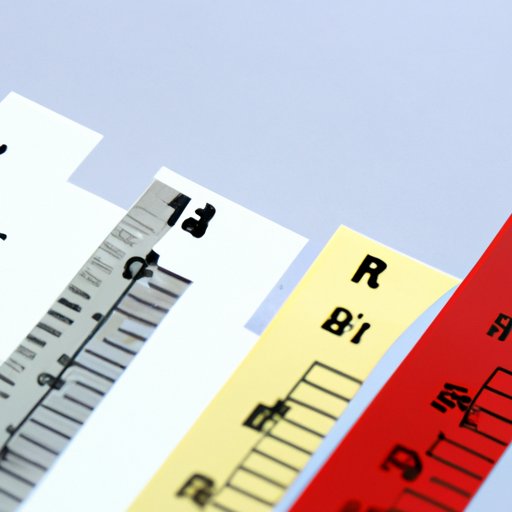
I. Introduction
Uncertainty in measurement refers to the range of values within which the true value of a quantity is expected to lie. It is an essential concept in scientific research, particularly in fields that require precise and accurate measurements of physical quantities. In this article, we will explore how to calculate uncertainty using various methods and tools. Our aim is to provide scientists and researchers with a comprehensive guide on uncertainty calculation.
II. The Importance of Uncertainty in Measurement
Uncertainty is a critical component of measurement accuracy. A measurement is said to be accurate if it is close to the true value of the quantity being measured. However, no measurement is ever entirely accurate due to external factors that may affect the measurement process. It is therefore vital to quantify the level of uncertainty associated with a measurement to determine how close it is to the true value. Accurate uncertainty calculations are essential for scientific research, as they help in making informed decisions based on the reliability of measurement results.
Inaccurate uncertainty calculations can have serious consequences. In fields such as medical research, inaccurate measurements can result in incorrect diagnoses and treatments, potentially leading to fatal consequences. In other areas, such as climate science, inaccurate measurements can impact decision-making and policy development based on flawed data.
III. Calculating Uncertainty Using the Standard Deviation Method
The standard deviation method is one of the most commonly used methods for calculating uncertainty. The following steps are involved:
- Take multiple measurements of the quantity in question
- Calculate the average of the measurements
- Calculate the standard deviation of the measurements using a formula
- Multiply the standard deviation by a coverage factor to obtain the expanded uncertainty.
For example, let’s say we want to measure the length of a book. We take five measurements and obtain the following results: 10.1cm, 10.2cm, 10.0cm, 10.3cm, and 10.2cm. The average of these measurements is 10.16cm, and the standard deviation is 0.14cm. If we use a coverage factor of two, the expanded uncertainty is 0.28cm. This means that we can be 95% confident that the true length of the book lies within the range of 10.16 +/- 0.28cm.
IV. Precision and Accuracy in Uncertainty Calculation
Precision and accuracy are essential concepts when it comes to uncertainty calculation. Precision refers to the degree of reproducibility of a measurement. A measurement is said to be precise if repeated measurements of the same quantity yield consistent results. Accuracy, on the other hand, refers to how close a measurement is to the true value of the quantity being measured. A measurement is said to be accurate if it is close to the true value, even if subsequent measurements are inconsistent.
Accounting for precision and accuracy in uncertainty calculations is crucial. The standard deviation method described above takes into account precision, but not accuracy. It is therefore recommended to use methods that consider both factors to ensure accurate uncertainty calculations.
V. Calculating Uncertainty Using Statistical Software
Statistical software can be a powerful tool for calculating uncertainty, especially for complex measurements involving multiple variables. Some commonly used statistical software applications include Microsoft Excel, MATLAB, and R. These software tools use various methods, such as Monte Carlo simulation and Bayesian inference, to estimate uncertainty values.
When using statistical software, it is essential to understand the tools and parameters involved in uncertainty calculations. These include distribution functions, random variables, and error models. A thorough understanding of these concepts is essential to ensure accurate and reliable uncertainty calculations.
VI. Reducing Uncertainty in Measurements
Reducing uncertainty is essential for accurate and reliable measurements. The following are some effective ways to reduce uncertainty:
- Use appropriate instruments calibrated to traceable standards
- Choose appropriate experimental methods that minimize sources of error
- Take multiple measurements and calculate the average
- Analyze data using appropriate statistical methods
By reducing uncertainty, measurements become more accurate and reliable, leading to better-informed decisions based on reliable data.
VII. Reporting and Communicating Uncertainty Values
Reporting and communicating uncertainty values is critical in scientific research. The following are some best practices:
- Report uncertainty values along with the measurement results
- Use appropriate units to express uncertainty values
- Ensure that uncertainty values are clearly and accurately presented
- Provide a clear definition of the method used to calculate the uncertainty values
By following best practices, scientists and researchers can ensure that uncertainty values are presented accurately, making it easier for others to understand and use the data.
VIII. Real-Life Applications of Uncertainty Calculations
Uncertainty calculations are critical in many fields, including medical research, climate science, and engineering. In medical research, accurate measurements are essential for identifying and treating diseases. Any inaccuracy due to incorrect uncertainty calculations can lead to incorrect diagnoses and treatment, which can be fatal. In climate science, measurements of atmospheric concentrations of pollutants such as carbon dioxide can influence policy decisions related to climate change. These measurements need to be accurate and reliable to ensure that policies are based on the best available data.
IX. Conclusion
Uncertainty calculations are fundamental in scientific research. By quantifying the uncertainty associated with measurements, scientists and researchers can make informed decisions based on reliable data. This article has explored various methods of calculating uncertainty, including the standard deviation method and software-based methods. We have also discussed best practices for reducing uncertainty, reporting uncertainty values, and the real-life applications of uncertainty calculations. We encourage scientists and researchers to apply the knowledge gained from this article to their research and experiments, leading to more accurate and reliable results.





